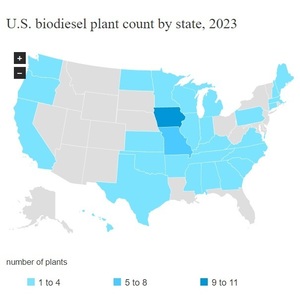EIA: US biodiesel capacity down in 2023

September 7, 2023
BY Erin Krueger
U.S. biodiesel production capacity fell by 169 MMgy between Jan. 1, 2022, and Jan. 1, 2023, according to data released by the U.S. Energy Information Administration in August. The number of biodiesel plants fell by 13.
The EIA data indicates that the U.S. had 59 biodiesel plants with a combined 2.086 billion gallons of production capacity as of the beginning of this year, compared to 72 facilities with a combined 2.255 billion gallons of capacity as of the same time last year.
Advertisement
Petroleum Administration for Defense District (PADD) 2, which is located in the Midwest, contains the highest number of biodiesel plants at 33, down from 37 last year. PADD 1, located along the East Coast, has 10 facilities, down from 14 last year. PADD 3, located along the Gulf Coast, has nine facilities, down from 12 last year, The number of facilities in PADD 5, which includes the West Coast, dropped from nine in 2022 to seven in 2023. PADD 4, the Rocky Mountain Region, had zero biodiesel plants in both years.
Despite four plants that closed in PADD 2 between 2022 and 2023, capacity increased by 17 MMgy. Capacity also increased by 6 MMgy in PADD 5 despite two plant closings. Capacity fell by 34 MMgy in PADD 1 and by 157 MMgy in PADD 3.
Advertisement
Related Stories
The U.S. Energy Information Administration maintained its forecast for 2025 and 2026 biodiesel, renewable diesel and sustainable aviation fuel (SAF) production in its latest Short-Term Energy Outlook, released July 8.
XCF Global Inc. on July 10 shared its strategic plan to invest close to $1 billion in developing a network of SAF production facilities, expanding its U.S. footprint, and advancing its international growth strategy.
U.S. fuel ethanol capacity fell slightly in April, while biodiesel and renewable diesel capacity held steady, according to data released by the U.S. EIA on June 30. Feedstock consumption was down when compared to the previous month.
XCF Global Inc. on July 8 provided a production update on its flagship New Rise Reno facility, underscoring that the plant has successfully produced SAF, renewable diesel, and renewable naphtha during its initial ramp-up.
The USDA’s Risk Management Agency is implementing multiple changes to the Camelina pilot insurance program for the 2026 and succeeding crop years. The changes will expand coverage options and provide greater flexibility for producers.
Upcoming Events










